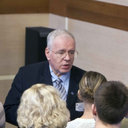[Antistress and angioprotective influence of nitric oxide in epilepsy-prone rats of Krushinskiĭ-Molodkina strain].
Keywords
Abstract
In rats of Krushinsky-Molodkina strain (KMR), the audiogenic stress induced epileptiform seizure and development of acute disturbances of cerebral circulation of hemorrhagic nature. The inhibitor of NO-synthase (L-NNA) increased the severity of clinical symptoms, mortality, and the intensity of intracranial hemorrhages. In contrast, L-arginine elevated the resistance of KMRs to acoustic stress. The intensity of nitrergic innervation was analyzed in preparations of the middle cerebral artery with the use of histochemical NADPH-diaphorase staining. In preparations of control KMRs, a net of NADPH-positive perivascular nerve fibers was found, while in experimental KMRs, in an hour after sound stimulation, such fibers practically were not revealed. Preliminary exposure of KMRs in hypoxic conditions (1 hour in hypobaric chamber at simulated altitude of 5000 m above the sea level) decreased the development of stress lesions. The protective effect of hypoxic training disappeared after the administration of NO-synthase inhibitor (L-NNA). The study demonstrated participation of nitric oxide (NO) in adaptive reactions of cerebral hemodynamics linked with the significant increase of cerebral blood flow.




